With Ollas you put an end to daily watering: With the help of clay pots, your garden plants are evenly supplied with water for several days.

Watering plants with Ollas is a method that has been known for thousands of years to make work easier and save water in the garden. In this article you can read how to use Ollas for irrigation, what advantages they offer and how to build Ollas yourself.
contents
- What are Ollas and how do they work?
- Use Ollas correctly
- Build Ollas yourself: instructions
What are Ollas and how do they work?
Ollas (pronounced "Ojas") are bulbous clay vessels that are used to water the garden. But how do Ollas work? The often amphora-like clay vessels are buried up to the neck in the ground and can then be filled with water. Due to the porosity of the clay, the water is slowly and continuously released into the soil. The functioning of ollas is related to the soil water tension, also called suction tension. This is greater the drier the soil is, because then it becomes "more absorbent". Only when the suction tension in the substrate is greater than that of the clay pot does water leave the olla. Conversely, this means that the soil is only moistened when it is dry - all by itself as long as the container is full.
tip: Work with the same functional principle as Ollas clay cone, which is mainly used for watering indoor plants. Unlike Ollas, the water reservoir is not underground in the clay pot itself. Instead, an upside-down bottle of water is placed on the clay cone, which is about the size of a finger. Read here how to use clay cones correctly.
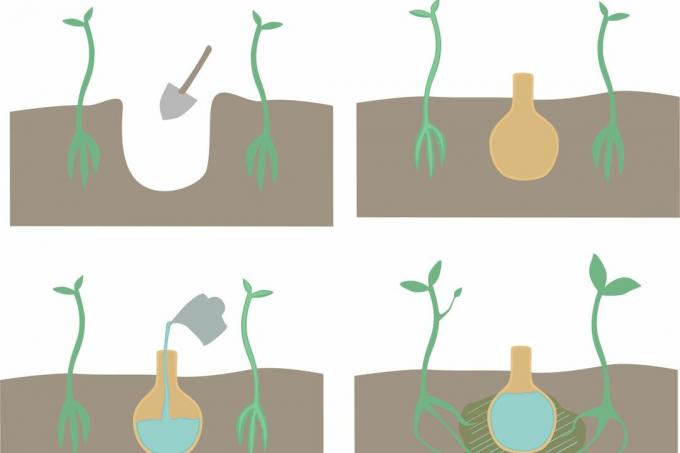
What are the benefits of irrigation with Ollas?
- Reduced workload: With Ollas for watering, the daily watering comes to an end. Because of the slow release of water through the clay walls, the plant roots are supplied with water for a longer period of time. Ollas are therefore also suitable for watering the garden during a short holiday.
- Reduced water loss: Since it is a so-called underfloor irrigation, i.e. underground irrigation, evaporation is reduced. This means that less water evaporates from the soil surface. In this way, up to 70% of the water is saved compared to irrigation. The liquid is therefore used much more efficiently.
- Less weeding: Because the soil surface remains drier, the seeds of weeds germinate more poorly. The likelihood of sprouting weeds in your bed decreases.
- Fewer diseases and pests: Moisture-loving fungal diseases like that downy mildew or the Late blight and late blight put an end to it by watering with Ollas, as the leaves of the plants do not get wet when watering. Snails also have a harder time crawling over the dry soil surfaces.
- Deeper Rooting: In contrast to conventional watering, watering with Ollas not only wets the top layer of soil, but also deeply moistens the soil. Your garden plants are stimulated to develop deeper roots.
- Cost less: Irrigation with Ollas is an inexpensive alternative, for example to a drip hose system. This is especially true if you build the Ollas yourself. You can find out how this works further down in the article.

The many benefits of irrigation with Ollas have been known for thousands of years. This type of irrigation was already described in China's oldest agricultural guidebook, the "Book of Fan Shengzhi". Irrigation with clay was also known in the ancient cultures of South America: the word olla comes from Spanish.
Tip: Ollas are particularly suitable for watering beds on slopes. Because the irrigation water runs off quickly there and cannot penetrate deep into the ground.
Use Ollas correctly
The first step is to dig a hole in the ground where the Olla is to be placed. This is best done at the beginning of the year when the garden plants are still small and you are less likely to destroy roots when digging. The Olla is placed in the hole and filled up with earth up to the neck. Then fill the Olla with water and put a lid on the opening to avoid dirt and small animals falling in.
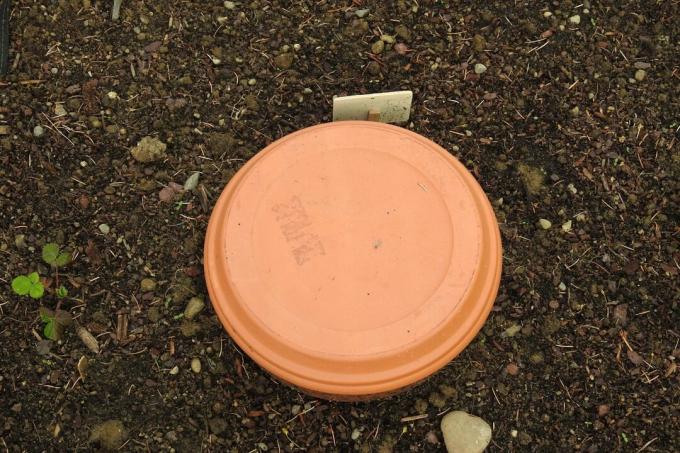
How often do you have to refill the Olla? A rough guideline for filling up the Ollas is to refill the water about once or twice a week. The frequency is highly dependent on the garden soil, the amount of rainfall, the water needs of the plants and the porosity of the soil. For example, sandy subsoil is less able to store water than clayey and loamy soils, but due to its small proportion of fine pores it can also build up less suction pressure. On the other hand, the Olla empties clayey substrate more efficiently thanks to its high suction power. Thirsty plants, wind, high levels of sunlight and dry soil also accelerate the draining of the Olla.
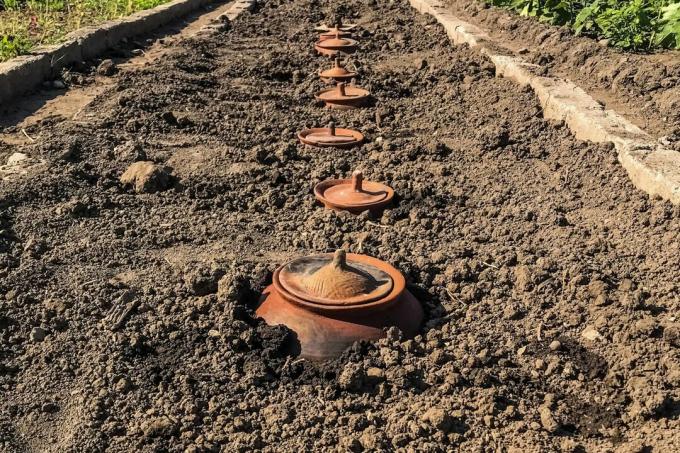
Which area can be irrigated with an Olla? There is no general answer to this question either, because it depends heavily on the size of the Olla and the type of soil. As a rough guide, plants within a 50 to 100 cm radius will benefit from watering with Ollas. In sandy soils, the water seeps away faster than it can spread laterally. The radius in which the plants benefit from the olla is therefore smaller. Therefore, in sandy soils, a narrower distance between the ollas must be maintained. In silty and clayey substrates, the benefiting area is larger. It makes sense to place the plants in a circle around the Olla. Creeping plants such as the pumpkin (Cucurbita maxima), because these will grow around the Olla all by themselves.
tip: Ollas are ideal for watering raised beds. One Olla is usually sufficient for this. Due to the lower soil volume in raised beds, the soil dries out particularly quickly here. Watering with Ollas can help here.
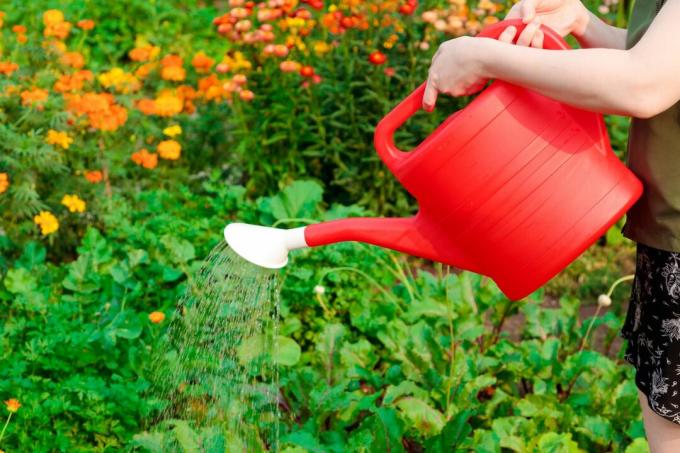
The perfect complement to watering with Ollas is mulching. Because the mulch layer means that even less water evaporates from the soil and you have to water even less frequently. For example, use grass clippings, leaves or a permanent variety like ours Plantura organic pine bark. Due to regular checks, it is less polluting than the frequently used bark mulch and, due to its coarse structure, remains on the bed for a particularly long time in order to protect the soil.
Build Ollas yourself: instructions
Instead of buying the bulbous clay pots, you can simply make the Ollas yourself for watering. You need:
- Two terracotta/clay pots (must be unglazed)
- A flower pot coaster
- Hot glue, tile adhesive is also suitable
- An uncurved potsherd
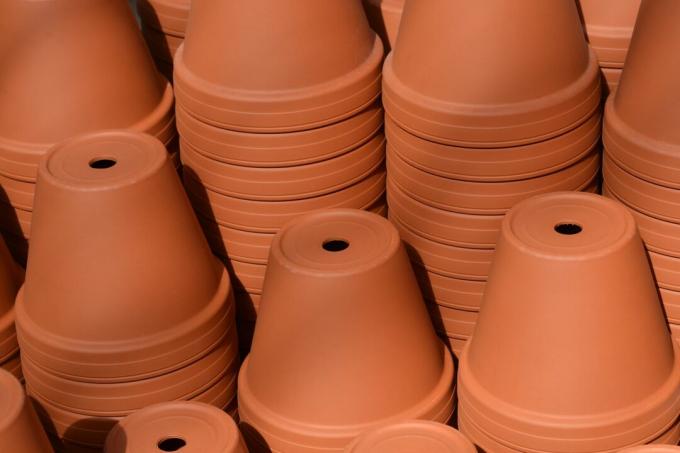
You can build Ollas yourself in 3 simple steps:
- Glue the two clay pots together with the opening. No more water should get through the gap.
- Now glue the uncurved potsherd to one of the drainage holes. As an alternative to the potsherd there are, for example, some mortar, silicone, a flat stone or a cork that you can seal with a little glue.
- You can fill the home-made Olla with water (possibly with the help of a funnel) via the unclosed drainage hole of the other pot. The pot saucer serves as a lid for the home-made Olla.
Olla is ready! Even just a clay pot with a closed drainage hole can be enough as an Olla. It is easier to fill but has a smaller volume.
Other methods for Plant watering on vacation see our article on top tips for the holiday season.



